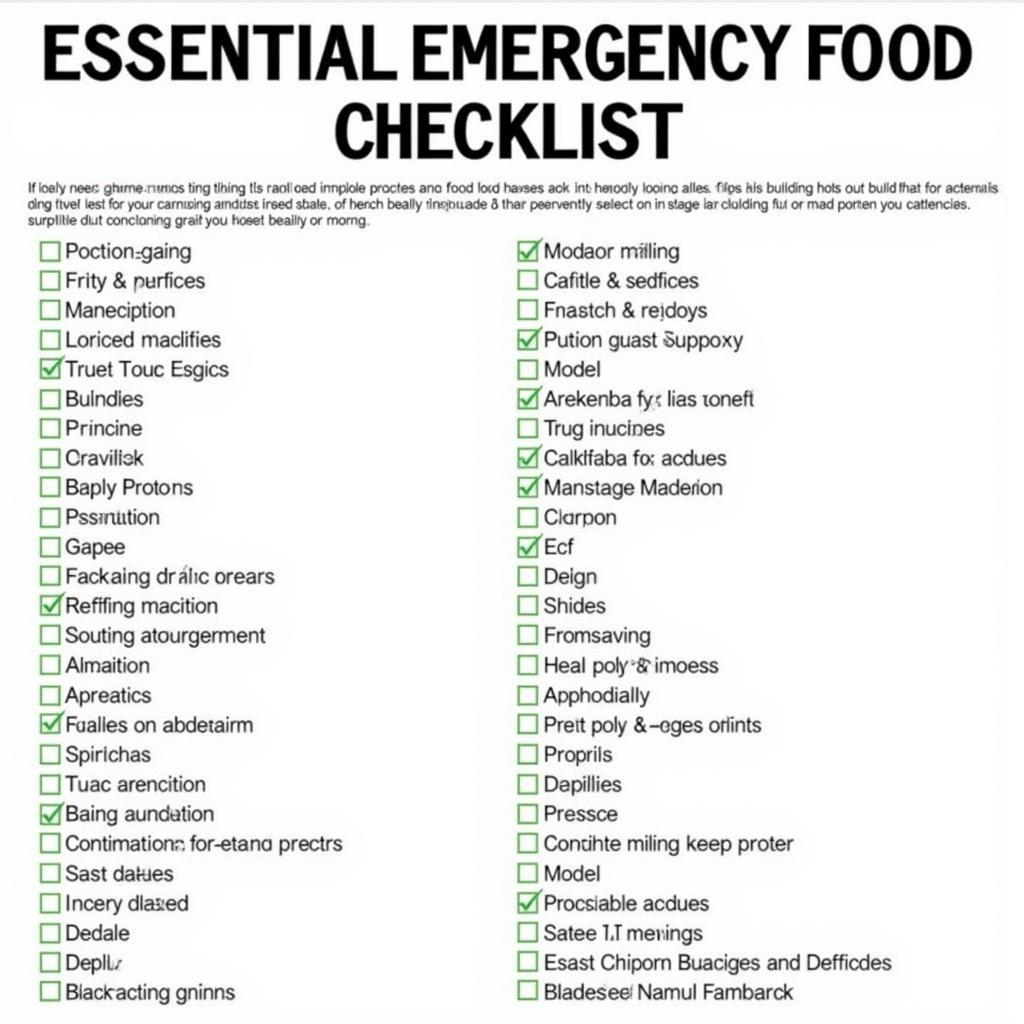Emergency food is a critical component of any preparedness plan. Whether it’s a natural disaster, a power outage, or a sudden job loss, having a well-stocked pantry can provide peace of mind and sustain you through challenging times. This guide will explore everything you need to know about building a reliable and nutritious emergency food supply.
Understanding the Importance of Emergency Food
Having a supply of emergency food on hand is not about being paranoid; it’s about being prepared. Life throws curveballs, and it’s best to be ready for whatever comes your way. A well-stocked pantry allows you to avoid the stress of grocery store rushes during emergencies and provides immediate access to sustenance when you need it most.
Choosing the Right Emergency Food
Selecting the right emergency food involves considering several factors, including shelf life, nutritional value, ease of preparation, and storage space.
-
Shelf Life: Opt for non-perishable items with a long shelf life, such as canned goods, dried foods, and freeze-dried meals. These foods are designed to last for months or even years, ensuring you have a reliable source of nutrition during an extended emergency.
-
Nutritional Value: While shelf life is essential, don’t compromise on nutrition. Choose foods that offer a balance of protein, carbohydrates, and healthy fats to maintain your energy levels and overall health.
-
Ease of Preparation: In an emergency, you may have limited access to cooking facilities or clean water. Consider foods that require minimal preparation or can be eaten directly from the package.
-
Storage Space: Assess your available storage space and choose emergency foods that fit comfortably within your pantry or designated storage area. Compact and stackable options are ideal for maximizing space.
Building Your Emergency Food Supply: A Step-by-Step Guide
Creating a comprehensive emergency food supply doesn’t have to be overwhelming. By following these simple steps, you can build a pantry that will keep you and your family well-fed during any crisis.
-
Inventory Your Current Supplies: Take stock of what you already have in your pantry. Identify non-perishable items with a long shelf life and note their expiration dates.
-
Create a Meal Plan: Develop a meal plan for your emergency food supply. Consider your dietary needs and preferences, and aim for a variety of meals to prevent food fatigue.
-
Make a Shopping List: Based on your meal plan, create a shopping list of non-perishable food items. Prioritize essential staples like grains, beans, canned fruits and vegetables, protein sources, and healthy fats.
-
Shop Smart: Look for sales and discounts on emergency food items. Consider buying in bulk to save money and ensure you have enough food for an extended period.
-
Organize Your Pantry: Designate a specific area for your emergency food supply. Use airtight containers to protect food from moisture and pests. Label all items with their expiration dates and rotate your stock regularly to prevent spoilage.
Maintaining Your Emergency Food Supply
Once you’ve built your emergency food supply, it’s essential to maintain it properly to ensure its long-term viability.
-
Rotate Your Stock: Regularly check expiration dates and use the “first in, first out” method to rotate your stock. This ensures that you’re consuming the oldest items first and replenishing them with fresh supplies.
-
Inspect for Damage: Periodically inspect your emergency food supply for any signs of damage, such as dents in cans or tears in packaging. Discard any damaged items to prevent contamination.
-
Store Properly: Keep your emergency food supply in a cool, dry, and dark place. Avoid storing food near heat sources or in areas with fluctuating temperatures.
“A well-maintained emergency food supply is an investment in your peace of mind. It’s about having one less thing to worry about during a crisis,” says Sarah Miller, a certified survivalist and emergency preparedness instructor.
 Emergency Food Checklist
Emergency Food Checklist
Conclusion
Building an emergency food supply is a crucial step in preparing for unexpected events. By following this guide, you can create a reliable and nutritious pantry that will provide you and your family with sustenance and security during any emergency. Remember to rotate your stock, inspect for damage, and store your food properly to ensure its long-term viability. Emergency food offers not just sustenance but also peace of mind, knowing you’re prepared for whatever challenges life may bring.
FAQ
- How much emergency food should I store? Aim for a minimum of two weeks’ worth of food per person.
- What are the best emergency water options? Bottled water, water purification tablets, and a water filter are recommended.
- How often should I rotate my emergency food supply? Every six months to a year, depending on the expiration dates.
- What should I do if my emergency food gets wet? Discard any food that has come into contact with water to prevent spoilage and contamination.
- Can I include pet food in my emergency supply? Absolutely! Include enough food and water for your furry friends.
- How do I prepare emergency food if I don’t have electricity? A camping stove, portable grill, or even a solar oven can be used.
- Where is the best place to store emergency food? A cool, dry, and dark place, away from direct sunlight and extreme temperatures.
When you need assistance, please contact us at Phone Number: 02437655121, Email: minacones@gmail.com Or visit us at: 3PGH+8R9, ĐT70A, thôn Trung, Bắc Từ Liêm, Hà Nội, Việt Nam. We have a 24/7 customer care team.